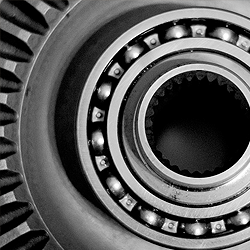Blog
How Do Self Lubricated Bearings Work?
July 28, 2017
Self-lubricated bearings ceaselessly counteract sliding element friction. That’s because, unlike their high-maintenance counterparts, this self-sufficient bearing type doesn’t require a supplementary oil feed system. Instead, the all-important lubricant, the oily stuff that produces a thin film around the bearing parts, is part of the machine component. Granted, the advantages of this friction-diminishing arrangement are many. They include that just mentioned low maintenance benefit, but just how do self-lubricating bearings work?
Alternative Mechanical Solutions
Some perspective is needed before we can go further. A mechanical bearing is a stressed device, and it’s the job of the lubricating agent to manage that stress. Imperceptible flaws on the sliding elements, high rotational loads, and several other contributing factors are pushing the rings and moving parts hard. The solution to this frictionally oppressive setting is to introduce a lubricant, a slippery film whose sole purpose is to “grease the wheels,” as it were. Submerged in an oil bath or connected to an oil-feed line, engineering methods ensure the lubricant is at hand, but they can and do fail. What if there was a bearing type that possessed a self-lubricating capability, though?
Self-Lubricating Bearings: The Operational Basics
The concepts proposed here are fascinating. For instead of employing a dense and impenetrable base material, we’re looking at metals and polymers that are endowed with a porous structure. There are the sintered bronze alloys we’ve already covered. Basically, the powdery metal is compacted into its product shape while it’s simultaneously impregnated with a lubricant. As the bearing enters its operational life, microscopic quantities of the slippery liquid are dynamically transferred to the moving parts until that uniform oil membrane covers every moving surface. How, then, does this process take place when the sintered bearing first enters service? A break-in period is mandated. That “priming” stage recommends a low-speed operational run so that the oily film is properly distributed.
Porous sintered materials and bronze-based capillary action lead the way when we’re referencing metal products. There are, of course, other self-lubricating bearings on the market. PTFE, a multisyllabic polymer that’s branded under the Teflon label, imbues thermoplastic components with a certain degree of lubricity. Then there are the oil-impregnated plastic bushings that benefit thermoplastic components. These parts use reinforced plastic fibres and a solid lubricant, as trapped inside the closed cells of the polymer material, to attenuate friction. Finally, there are graphite plugged bronze variants, bearings that rely on the flat micro structure of this commonly used form of carbon. Plastic or graphite, though, these alternatives don’t pack the lubricating power of a toughened, sintered bronze bearing.
Optimized by: Netwizard SEO

